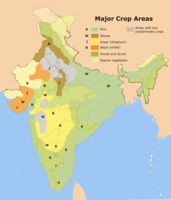
Photo from wikipedia
Purpose Climate warming is anticipated to change the terrestrial carbon/nitrogen cycle through its impact on the fluxes of greenhouse gases such as CO 2 and N 2 O. This study… Click to show full abstract
Purpose Climate warming is anticipated to change the terrestrial carbon/nitrogen cycle through its impact on the fluxes of greenhouse gases such as CO 2 and N 2 O. This study investigated the effect of diurnal warming and acid rain on CO 2 and N 2 O emissions from soil-plant systems in a winter wheat–soybean rotation cropland. Materials and methods Field rotational experiments of winter wheat and soybean were conducted by simulating diurnal warming and acid rain. Manipulated experiments included the control (CK), diurnal warming (T, + 2 °C), acid rain (AR, pH = 2.5), and the combined treatment (TAR, + 2 °C and acid rain). CO 2 and N 2 O fluxes from soil-plant systems were measured using a static chamber-gas technique. Results and discussion The results showed that in the winter wheat and soybean growing seasons, compared with CK treatment, T, AR, and TAR treatments did not change the accumulative amount of CO 2 emission (AAC) across the full growth period ( p ˃ 0.05), although T treatment significantly increased soil AAC ( p < 0.05) at the grain filling-maturity stage. On the contrary, T and AR treatments significantly increased the accumulative amount of N 2 O emission (AAN) in winter wheat and soybean croplands ( p < 0.05), which was attributed to leaf nitrate reductase activity, total biomass, and soil NO 3 − –N content. In addition, there was a significant interaction between warming and acid rain on N 2 O flux. The AAN from the winter wheat cropland under treatments was in the order: TAR ˃ AR ˃ T ˃ CK. Conclusions Our findings suggest that diurnal warming and acid rain had no significant effect on CO 2 emissions from soil-plant systems, but significantly increase N 2 O emissions in winter wheat and soybean growing seasons. Moreover, diurnal warming would strengthen the positive effect of acid rain on N 2 O emissions from soil-plant systems in winter wheat farmland.
Journal Title: Journal of Soils and Sediments
Year Published: 2020
Link to full text (if available)
Share on Social Media: Sign Up to like & get
recommendations!